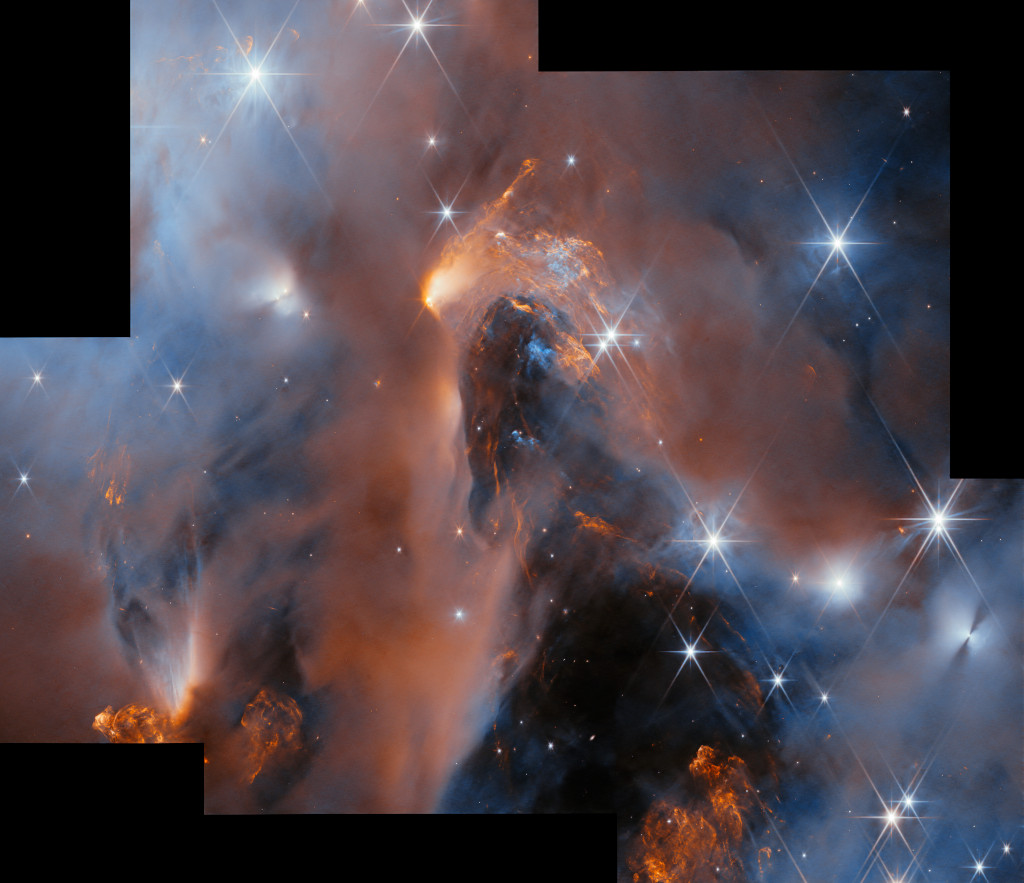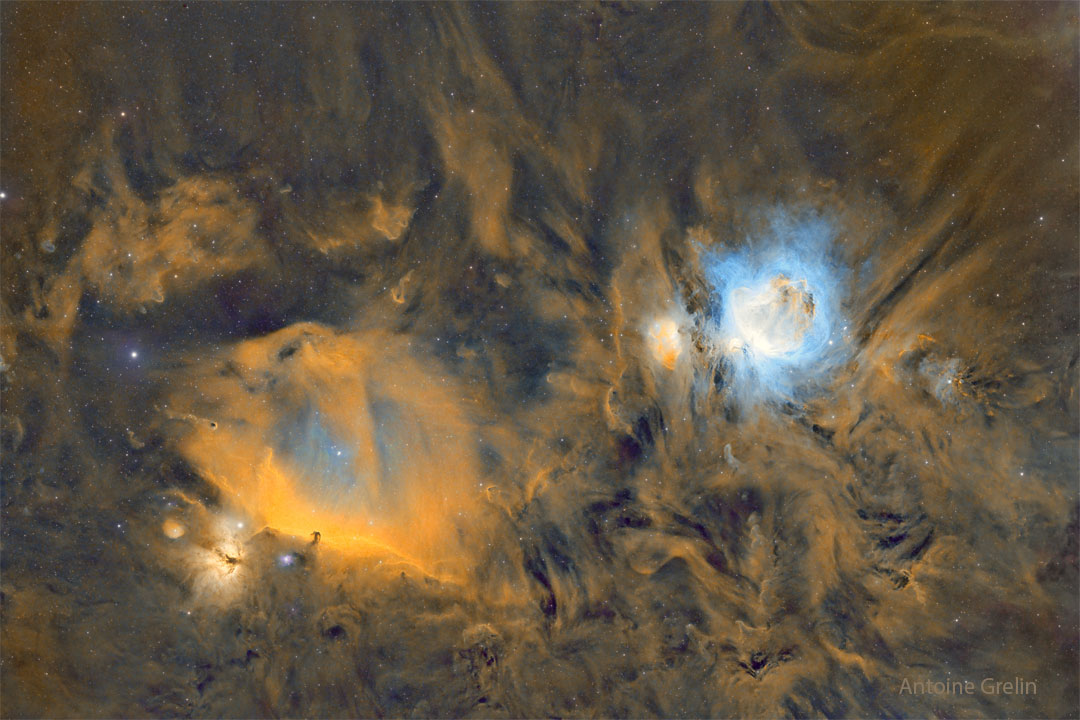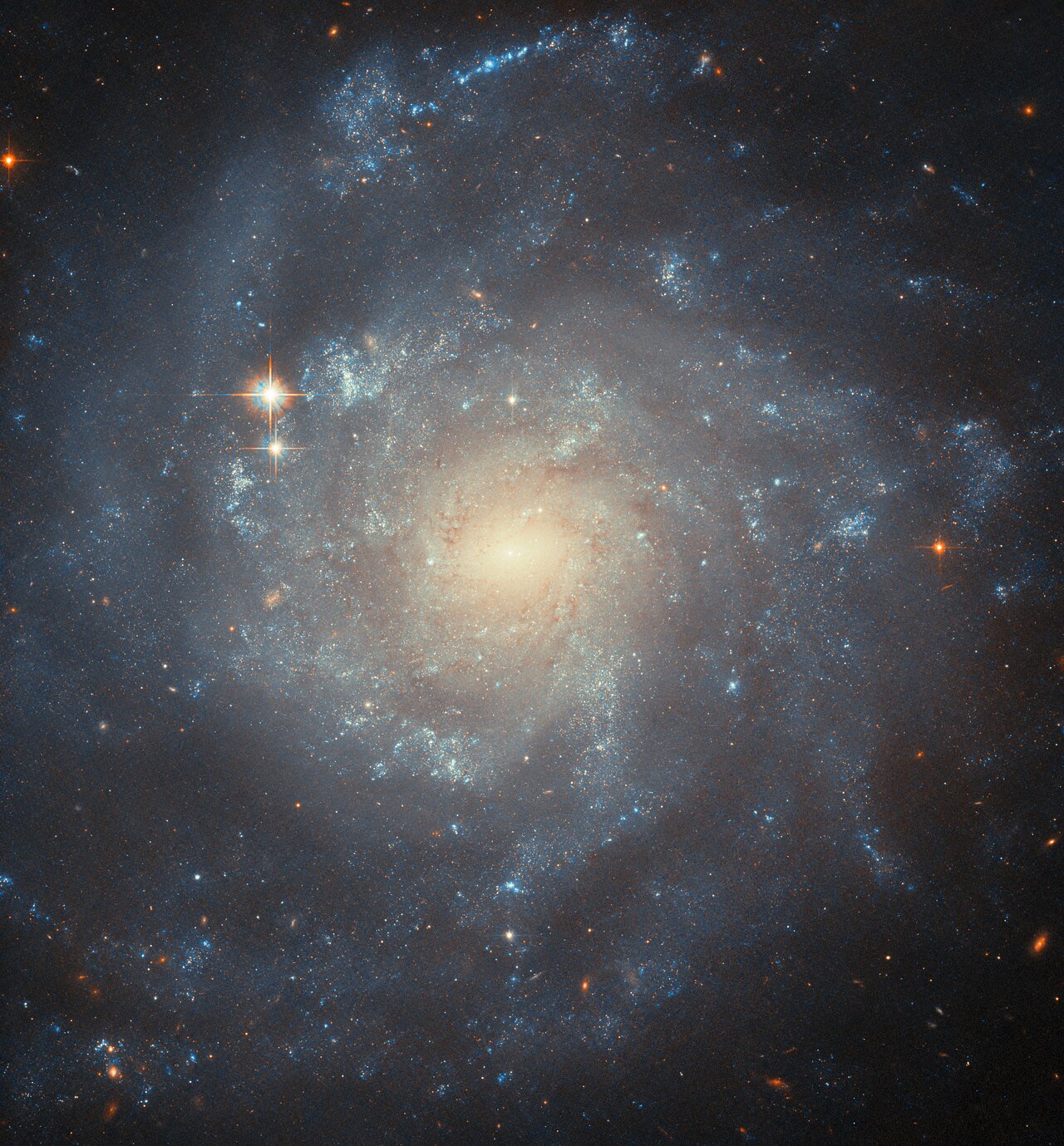Blog
This spectacular mosaic of images from the James Webb Space Telescope peers into the heart of young star cluster NGC 1333. A mere 1,000 light-years distant toward the heroic constellation Perseus, the nearby star cluster lies at the edge of the large Perseus molecular cloud. Part of Webb’s deep exploration of the region to identify low mass brown dwarf stars and free floating planets, the space telescope’s combined field of view spans nearly 2 light-yearsacross the dusty cluster’s turbulent stellar nursery. In fact, NGC 1333 is known to harbor stars less than a million years old, though most are hidden from optical telescopes by the pervasive stardust. The chaotic environment may be similar to one in which our own Sun formed over 4.5 billion years ago.

more...
Neil Ellwood Peart OC (September 12, 1952 – January 7, 2020) was a Canadian and American musician, known as the drummer and primary lyricist of the rock band Rush. He was known to fans by the nickname ‘The Professor’, derived from the Gilligan’s Island character of the same name. His drumming was renowned for its technical proficiency and his live performances for their exacting nature and stamina. Peart earned numerous awards for his musical performances, including an induction into the Modern Drummer Readers Poll Hall of Fame in 1983 at the age of thirty, making him the youngest person ever so honoured.
Peart was born in Hamilton, Ontario, and grew up in Port Dalhousie (now part of St. Catharines). During adolescence, he floated between regional bands in pursuit of a career as a full-time drummer. After a discouraging stint in England, Peart returned home to concentrate on music where he joined Rush, a Toronto band, in mid-1974, six years after its formation. Together they released nineteen studio albums, with ten exceeding a million copies sold in the United States. Billboard lists the band third in “most consecutive gold or platinum albums by a rock band”.
Early in his career, Peart’s performance style was deeply rooted in hard rock. He drew most of his inspiration from drummers such as Keith Moon, Ginger Baker, and John Bonham, players who at the time were at the forefront of the British hard rock scene. As time passed, he began to emulate jazz and big band musicians Gene Krupa and Buddy Rich. In 1994, Peart became a friend and pupil of jazz instructor Freddie Gruber. It was during this time that Peart revamped his playing style by incorporating jazz and swing components.
In addition to serving as Rush’s primary lyricist, Peart published several memoirs about his travels. His lyrics for Rush addressed universal themes and diverse subjects including science fiction, fantasy, and philosophy, as well as secular, humanitarian, and libertarian themes. Peart wrote a total of seven nonfiction books focused on his travels and personal stories. He also coauthored with Kevin J. Anderson three steampunkfantasy novels based on Rush’s final album, Clockwork Angels. The two also wrote a dark fantasy novella, Drumbeats, inspired by Peart’s travels in Africa.
Peart announced his retirement from touring in an interview with Drumhead Magazine in December 2015. In January 2018, bandmate Alex Lifeson confirmed that Rush had disbanded also due to Peart’s health issues. During his last years Peart lived in Santa Monica, California, with his wife, Carrie Nuttall, and daughter. After a three-and-a-half-year illness, Peart died of glioblastoma on January 7, 2020, at age 67.
more...
Maria Muldaur (born Maria Grazia Rosa Domenica D’Amato; September 12, 1942) is an American folk and blues singer who was part of the American folk music revival in the early 1960s. She recorded the 1973 hit song “Midnight at the Oasis” and has recorded albums in the folk, blues, early jazz, gospel, country, and R&Btraditions.
She was the wife of musician Geoff Muldaur and is the mother of singer-songwriter Jenni Muldaur.
more...“Papa” John DeFrancesco (September 12, 1940 – June 25, 2024) was an American jazz organist and vocalist, and father of Joey DeFrancesco and Johnny DeFrancesco. DeFrancesco died on June 25, 2024, at the age of 83.
more...



The dark Horsehead Nebula and the glowing Orion Nebula are contrasting cosmic vistas. Adrift 1,500 light-years away in one of the night sky’s most recognizable constellations, they appear in opposite corners of the abovestunning mosaic. The familiar Horsehead nebula appears as a dark cloud, a small silhouette notched against the long glow of hydrogen — here shown in gold — at the lower left. Alnitak is the easternmost star in Orion’s belt and is seen as the bright star to the left of the Horsehead. Just below Alnitak is the Flame Nebula, with clouds of bright emission and dramatic dark dust lanes. The magnificent emission region, the Orion Nebula (aka M42), lies at the upper right. Immediately to its left is a prominent reflection nebula sometimes called the Running Man. Pervasive tendrils of glowing hydrogen gas are easily traced throughout the region.

Mickey Hart (born Michael Steven Hartman, September 11, 1943 Brooklyn, NY) is an American percussionist. He is best known as one of the two drummers of the rock band Grateful Dead. He was a member of the Grateful Dead from September 1967 until February 1971, and again from October 1974 until their final show in July 1995. He and fellow Dead drummer Bill Kreutzmann earned the nickname “the rhythm devils“.
more...
Leo Kottke (born September 11, 1945) is an American acoustic guitarist. He is known for a fingerpicking style that draws on blues, jazz, and folk music, and for syncopated, polyphonic melodies. He has overcome a series of personal obstacles, including partial loss of hearing and a nearly career-ending bout with tendon damage in his right hand, to emerge as a widely recognized master of his instrument. He resides in the Minneapolis area with his family.
Focusing primarily on instrumental composition and playing, Kottke also sings sporadically, in an unconventional yet expressive baritone described by himself as sounding like “geese farts on a muggy day”. In concert, Kottke intersperses humorous and often bizarre monologues with vocal and instrumental selections from throughout his career, played solo on six and twelve string guitars.
more...Victor Lemonte Wooten (born September 11, 1964 Mountain Home, ID) is an American bassist, songwriter, and record producer. He has been the bassist for Béla Fleck and the Flecktones since the group’s formation in 1988 and a member of the band SMV with two other bassists, Stanley Clarke and Marcus Miller. From 2017 to 2019 he recorded as the bassist for the metal band Nitro.
He owns Vix Records, which releases his albums. He wrote the novel The Music Lesson: A Spiritual Search for Growth Through Music. He later released the book’s sequel, The Spirit of Music: The Lesson Continues, on February 2, 2021.
Wooten is the recipient of five Grammy Awards. He won the Bass Player of the Year award from Bass Player magazine three times and is the first person to win the award more than once. In 2011, he was ranked No. 10 in the Top 10 Bassists of All Time by readers of Rolling Stone magazine.
In 2018–2019 Wooten was diagnosed with a rare neurological condition called focal dystonia in his hands and upper body, which had been limiting his ability to play in previous years, but has since abated somewhat.
more...Hiram Law Bullock (September 11, 1955 – July 25, 2008) was an American guitaristknown mainly for playing in jazz funk and jazz fusion, but he also worked as a session musician in a variety of genres.
Bullock was born in Osaka, Japan, to African American parents serving in the U.S. military. At the age of two he returned to Baltimore, Maryland, with his parents and showed musical talent. He studied piano at the city’s Peabody Conservatory of Music, giving his first public performance at the age of six. After playing saxophone and bass guitar, he took up the electric guitar at age sixteen.
Bullock attended McDonogh School for Boys in Reisterstown, Maryland. He was captain of the band in middle school. He studied at the University of Miami, where he met guitarists Pat Metheny and Steve Morse, and bass players Jaco Pastorius and Will Lee. He paid for tuition by performing at nightclubs in Florida before moving to New York. He became best known for playing with Lee on Late Night with David Letterman and working with David Sanborn and Bob James. His work can be heard on Bob James’ Angela which is also the theme song for the TV show Taxi, Steely Dan‘s Gaucho (1980), Paul Simon‘s One Trick Pony (1980), Sting‘s …Nothing Like the Sun (1987) and Billy Joel‘s The Stranger (1977). He also worked with Harry Belafonte, Marcus Miller, Carla Bley, Miles Davis, Ruben Rada, and Gil Evans.
more...Roosevelt “Baby Face” Willette (September 11, 1933 – April 1, 1971) was an American hard bop and soul-jazz musician who played the Hammond organ.
He was born Roosevelt James Willett (no “e”), in Little Rock, Arkansas, in 1933 according to researchers Bob Eagle and Eric LeBlanc, though other sources state 1934 or 1937. According to the liner notes on his first Blue Note album, Grant’s First Stand, Willette was born in New Orleans.
His mother was a missionary who played the piano in the church where his father was a minister. As a result, his musical roots were in gospel. Willette became involved in music by playing the piano for various gospel groups, and accompanied his sisters Dorothy and Georgia, who toured and recorded as the Willett Sisters. He spent his early career travelling across the United States, Canada and Cuba, as pianist with the bands of King Kolax, Joe Houston, Johnny Otis and Big Jay McNeely, among others.
He made his first recording as Baby Face Willette (“Wake Up, Get Out” b/w “Cool Blues”) in Los Angeles in 1952, but soon moved to Chicago and married. He recorded tracks including “Can’t Keep From Lovin’ You” and “Why” for Vee-Jay Records that year, but they were not released until late 1955. He played in both rhythm and blues and jazz bands, playing piano before switching to organ around 1958. His organ playing was inspired by Jimmy Smith‘s work, though Willette’s style is more heavily influenced by gospel, blues and soul jazz than Smith’s. Willette was also a professional hairdresser. Before his time in New York City, he was based out of Milwaukee, playing with his vocalist wife Jo Gibson at clubs such as The Flame Club, The Pelican Club, The Moonglow and Max’s among others.
more...The subject of this Hubble Picture of the Week is a spiral galaxy in the constellation Virgo named NGC 5668. It is relatively near to us at 90 million light-years from Earth and quite accessible for astronomers to study with both space- and ground-based telescopes. At first blush, it doesn’t seem like a remarkable galaxy. It is around 90 000 light-years across, similar in size and mass to our own Milky Way galaxy, and its orientation nearly face-on to us shows open spiral arms made of cloudy, irregular patches.
One noticeable difference between the Milky Way galaxy and NGC 5668 is that this galaxy is forming new stars 60% more quickly. This fact belies a galaxy with churning clouds and flows of gas, inclement weather that forms excellent conditions for the formation of new stars! Two main drivers of star formation have been identified by astronomers. Firstly, this high-quality Hubble snapshot reveals a bar at the centre; it might look more like a slight oval shape than a real bar, but it appears to have impacted the galaxy’s star formation rate, as central bars do in many spiral galaxies. Secondly, high-velocity clouds of hydrogen gas have been tracked moving vertically between the disc of the galaxy and the spherical, faint halo which surrounds it. These can be produced by the strong stellar winds of hot, massive stars, and they contribute gas to new star-forming regions.
The enhanced star formation rate in NGC 5668 comes with a corresponding abundance of supernova explosions. Three have been spotted in the galaxy, in 1952, 1954 and 2004. In this image, Hubble was used to examine the surroundings of the Type II SN 2004G, seeking to study the kinds of stars that end their lives as this kind of supernova.

Roy James Brown (September 10, 1920 or 1925 – May 25, 1981) was an American blues singer who had a significant influence on the early development of rock and roll and the direction of R&B. His original song and hit recording “Good Rockin’ Tonight” has been covered by many artists including Wynonie Harris, Elvis Presley, Bruce Springsteen, Paul McCartney, Joe Ely, Ricky Nelson, Jerry Lee Lewis, Pat Boone, James Brown, the Doors, and the rock group Montrose. Brown was one of the first popular R&B singers to perform songs with a gospel-steeped delivery, which was then considered taboo by many churches. In addition, his melismatic, pleading vocal style influenced notable artists such as B.B. King, Bobby Bland, Elvis Presley, Jackie Wilson, James Brown and Little Richard.
more...José Montserrate Feliciano García ( born September 10, 1945) is a Puerto Rican musician. He recorded many international hits, including his rendition of the Doors‘ “Light My Fire” and his self-penned Christmas song“Feliz Navidad“. Music genres he explores consist of fusion of many styles, such as Latin, blues, jazz, soul and rock music, created primarily with the help of his signature acoustic guitar sound.
In the United States, Feliciano became popular in the 1960s, particularly after his 1968 album Feliciano! reached number 2 on the music charts. Since then in his career, he released over 50 albums worldwide in both English and Spanish language.
more...Herman Davis “Dave” Burrell (born September 10, 1940) is an American jazzpianist. He has played with many jazz musicians including Archie Shepp, Pharoah Sanders, Marion Brown and David Murray.
Born in Middletown, Ohio, United States, Burrell grew fond of jazz at a young age after meeting Herb Jeffries. Burrell studied music at the University of Hawaii from 1958 to 1960, then, beginning in 1961, attended the Berklee College of Music in Boston, graduating with degrees in composition/arranging and performance in 1965.While in Boston, he played with Tony Williams and Sam Rivers.
In 1965, Burrell moved to New York City, where he worked and recorded with Grachan Moncur III, Marion Brown, and Pharoah Sanders. He also started the Untraditional Jazz Improvisational Team with saxophonist Byard Lancaster, bassist Sirone, and drummer Bobby Kapp. In 1968, Burrell co-founded The 360 Degree Music Experiencewith Grachan Moncur III and Beaver Harris and recorded two albums with the group. The following year, Burrell began an association with Archie Shepp, with whom he would play the 1969 Pan-African Festival in Algiers, and with whom he would go on to record nearly twenty albums.
more...More Posts
- Echos of Freedom by Rabindranath Tagore
- The Cosmos with Westerhout 5
- Tim Buckley Day
- Merle Saunders Day
- Fernando Sor Day
- World Music with ALASH
- Daily Roots with the Prophets
- Echos of Freedom by James Baldwin
- The Cosmos with NGC 7923
- Peter Gabriel Day
- Wardell Gray Day
- World Music with Yeni Türkü
- Daily Roots with Culture
- Echos of Freedom by Aung San Suu Kyi
- The Cosmos with NGC 4452
- Omar Hakim Day
- Bill Laswell Day
- Big John Wrencher Day
- World Music with Kalani Pe’a
- Daily Roots with U Roy